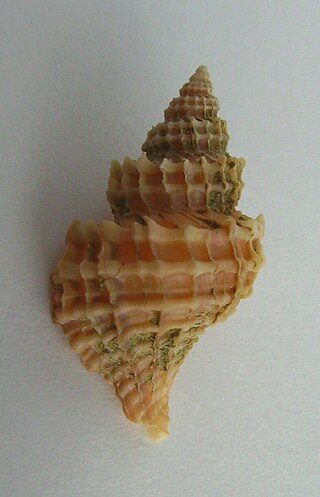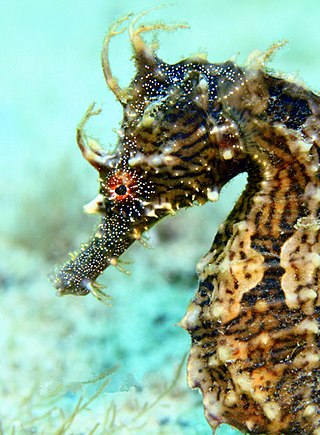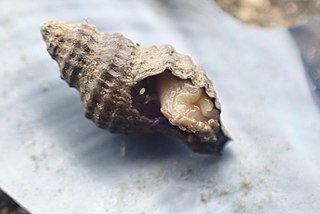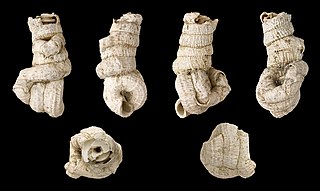
Homo is the genus that emerged from the genus Australopithecus and encompasses the extant species Homo sapiens and several extinct species classified as either ancestral to or closely related to modern humans, including Homo erectus and Homo neanderthalensis. The oldest member of the genus is Homo habilis, with records of just over 2 million years ago. Homo, together with the genus Paranthropus, is probably sister to Australopithecus africanus, which itself had split from the lineage of Pan, the chimpanzees.

Sea snail is a common name for slow-moving marine gastropod molluscs, usually with visible external shells, such as whelk or abalone. They share the taxonomic class Gastropoda with slugs, which are distinguished from snails primarily by the absence of a visible shell.

Xymene is a genus of predatory sea snails, marine gastropod molluscs in the family Muricidae, the rock snails, found in New Zealand.
Zeatrophon mortenseni is a species of predatory sea snail, a marine gastropod mollusc in the family Muricidae, the rock snails or murex snails.
Xymene warreni is a species of predatory sea snail, a marine gastropod mollusc in the family Muricidae, the rock snails or murex snails, and was first described in 1972 by Winston Ponder.

Xymene huttoni is a species of predatory sea snail, a marine gastropod mollusc in the family Muricidae, the rock snails or murex snails.
Xymene teres is a species of predatory sea snail, a marine gastropod mollusc in the family Muricidae, the rock snails or murex snails.
Xymene convexus is a species of predatory sea snail, a marine gastropod mollusc in the family Muricidae, the rock snails or murex snails.
Xymene pumilus is a species of predatory sea snail, a marine gastropod mollusc in the family Muricidae, the rock snails or murex snails.

Homo erectus is an extinct species of archaic human from the Pleistocene, with its earliest occurrence about 2 million years ago. Its specimens are among the first recognizable members of the genus Homo.

The lined seahorse, northern seahorse or spotted seahorse, is a species of fish that belongs to the family Syngnathidae. H. erectus is a diurnal species with an approximate length of 15 cm and lifespan of one to four years. The H. erectus species can be found in myriad colors, from greys and blacks to reds, greens, and oranges. The lined seahorse lives in the western Atlantic Ocean as far north as Canada and as far south as the Caribbean, Mexico, and Venezuela. It swims in an erect position and uses its dorsal and pectoral fins for guidance while swimming.

Freshwater snails are gastropod mollusks that live in fresh water. There are many different families. They are found throughout the world in various habitats, ranging from ephemeral pools to the largest lakes, and from small seeps and springs to major rivers. The great majority of freshwater gastropods have a shell, with very few exceptions. Some groups of snails that live in freshwater respire using gills, whereas other groups need to reach the surface to breathe air. In addition, some are amphibious and have both gills and a lung. Most feed on algae, but many are detritivores and some are filter feeders.

Engoniophos is a genus of sea snails, marine gastropod mollusks in the subfamily of the family Nassariidae.

Xymene plebeius is a species of sea snail, a marine gastropod mollusk in the family Muricidae, the murex snails or rock snails.
Petaloconchus erectus is a species of sea snail, a marine gastropod mollusk in the family Vermetidae, the worm snails or worm shells.

Petaloconchus is a genus of sea snails, marine gastropod mollusks in the family Vermetidae, the worm snails or worm shells.
Onobops is a genus of very small aquatic snails, operculate gastropod mollusks in the family Cochliopidae or in the Hydrobiidae.

Pagodulinae is a taxonomic subfamily of predatory sea snails, marine gastropod mollusks in the family Muricidae, the murex shells or rock shells.

Zeatrophon is a genus of sea snails, marine gastropod mollusks in the family Muricidae, the murex snails or rock snails.










